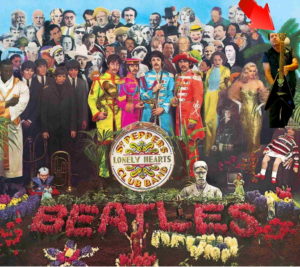Originally from my Facebook page
June 3, 2017
I’ve actually enjoyed my commute time this week — the 50th anniversary of the Beatles releasing “Sgt Pepper!”
While driving I flip around the radio dial to get the good parts of various stations as they go by and I have four PBS stations, which tend to do more special programs.
The “normal” radio stations did their share of Beatles tributes, but programs on PBS like “On Point” and “Fresh Air” give 30 to 60 minute interviews and profiles.
It was 50 years ago today, Sgt. Pepper taught the band to play. And I was a couple of years away from picking up the guitar and learning to play. But I had been a Beatles fan since their Ed Sullivan debut in 1964.
My grandparents had sold their grocery store and opened and ladies’ ready to wear shop on the main drag in Norton, KS (right next to the Lennox storefront on State Street for you Norton historians). Mom worked there — the first time she worked outside the home since baffling the world with three unusual sons.
The grandparents bought the first two 45 RPM records (check Wikipedia if you don’t know what those are) issued in the US — “I Want To Hold Your Hand” and “She Loves You” on the Parlophone label (before Capitol Records picked them up for US distribution) and played them for background music during the grand opening of The Wards For Ladies.
After the Grand Opening, the grandsons were gifted with these records — possibly still in the collection of brother Bart. I remember playing the records constantly and singing along at the top of my lungs. One memory that sticks with me is when Tim Sterrett came over and we played the records at high volume — I remember singing the bridge with these lyrics:
And when I touch you
I feel happy inside
It’s such a feelin’ that my love
I get hives
I get hives
I GET HIVES!
(I don’t think that was really the words, but that’s what it sounded like in all the excitement of Beatlemania)
When Sgt Pepper was released, believe it or not, most of the copies sold were in mono. After all, stereo home players were not owned except by audiophiles and the radio and TV sets were all mono.
I first heard the stereo version (on headphones) when I was in high school. I remember “Good Morning, Good Morning” ending with the farm animal noises bouncing between ears and I think at the very end is a horse galloping across the stereo spectrum. Also, on “A Day In The Life” the last verse is in the opposite ear from where the first verse played. The cacophony in the middle of the song swirls around and around too.
I was thrilled by the beauty of “She’s Leaving Home” — it sure wasn’t rock ‘n roll. And I really glommed on to “When I’m 64.” My parents asked me to play it on guitar and sing it for my grandma (who turned 64 in 1972, I think) and I played for my own mom when she turned 64.
Sgt Pepper was a landmark of audio recording experimentation. The machines they had at that time were only 4-tracks and there was massive overdubbing. The best recounting of the creation of this album (that I have read or heard) was the memoir by Abbey Road studio recording engineer Geoff Emerick — Here, There and Everywhere: My Life Recording the Music of the Beatles. The fab four were making all kinds of demands to producer George Martin and Emerick. Some of the things they came up with were absolutely wild — like putting a reel of tape on one machine, then unspooling it down the hallway to another machine in another room to get a long tape delay.
The Beatles are legendary and Sgt Pepper is rightfully a legend. Most in the know agree it isn’t the best album the Beatles ever made (some say it isn’t even the best album they made in 1967), but it was the signpost toward their final albums that showed the industry that albums were an art form and that music didn’t have to be tightly squeezed into narrow genres.
The fact that Paul McCartney and Ringo Starr are still alive and productive is amazing and wonderful — we shouldn’t take it for granted.
Now — I hope you are inspired to go out and listen and read and groove on the great gifts given to us by those four working class lads from Liverpool.
https://www.beatlesbible.com/…/geoff-emerick-here-there-an…/
Not following me on Facebook?
https://www.facebook.com/profile.php?id=100008477560132
